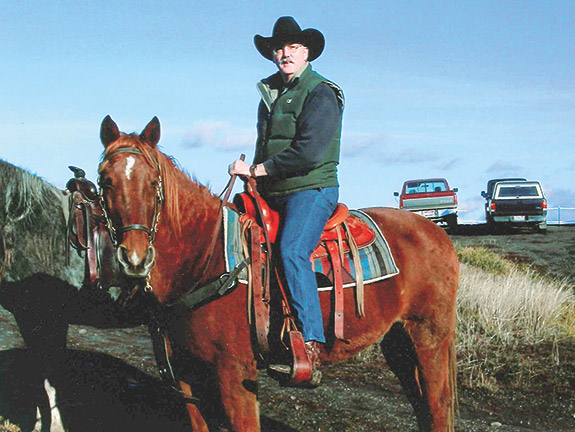On a Saturday afternoon last March, Matt Carroll got a curious Facebook message from the stepdaughter of his best friend, Tom Durnell. There had been a landslide near Tom’s home. His wife, Debbie, was at work. They couldn’t get in touch with Tom.
“At first it didn’t sound that ominous,” says Carroll, a professor in Washington State University’s School of the Environment, “like maybe the cell tower went out or something.”
Still, Carroll raised his wife from an afternoon nap and told her something was going on at Tom and Debbie’s.
“Her initial instinct,” says Carroll, “was start packing bags.”
Thus began a deeply personal journey into Carroll’s academic specialty, the human dimension of natural resource disasters. For 15 years, Carroll has studied the reactions of rural communities to wildfires—what works, what doesn’t work, how residents react to their losses and disruptions and the official response. He has interviewed hundreds of people, penning sociologically focused papers like, “Fire as a Galvanizing and Fragmenting Influence on Communities” and “Why Are Natural Disasters Not ‘Natural’ for Victims?”
Now he was driving into the emotional ground zero of one of the deadliest natural disasters in state history. The Oso mudslide engulfed 49 homes, changed the course of a river, and killed more than 40 people. Among them: Durnell, a retired carpenter with whom Carroll had made annual visits to the Pendleton Roundup and shared a love of country, western swing, and Appalachian music. Together the two men had collected thousands of recordings. Durnell’s home was carried 1,000 or so yards by the square-mile slide, which one geologist estimates moved as fast as 60 mph.

In some ways, Carroll had a rough outline of what to expect: the slow realization of the disaster’s magnitude, the anger of locals at both their loss and the slowness of the official response. Spending almost all his time in a shelter in Arlington’s Post Middle School, Carroll also felt the survivors’ isolation, their desire to know more, and frustration with outsiders’ view of the situation.
“One thing that I had not fully realized in my research was how isolating those shelters are,” he says. “They come and give you a briefing a couple times a day but it’s still a very isolating experience to be in that shelter.”
There’s never enough information, he says, and what information there is can be maddeningly incomplete, if not outright wrong.
“The national coverage you see or whatever media you might have available to you frustrates you, because they’re not getting it right,” he says. “They’re not being site-specific enough or they’re only seeing part of the picture. There’s always frustration on the part of local people with the way these stories are portrayed in the national media.”
Sadness pervaded the shelter. But no sooner would he return to Pullman to teach some classes than Carroll and his wife would be driving back over to Oso, like characters in the TV show Lost struggling to get back to the island they escaped.
“People outside the circle of this disaster could listen with great empathy,” he says, “but they don’t get it. They’re not living the same emotions that you’re living. There’s something comforting about going back in that shelter knowing you can hug anybody in that room and no one would question why you would do it. We all had a shared experience. No matter how many words you put on it to people outside that circle, no matter how empathetic people outside that circle were, you didn’t feel completely understood.”
On the slide’s first day, says Carroll, “it occurred to me that it looked like I lost my best friend.” That became even more apparent as the week unfolded and no new survivors were located.
At 10:37 a.m. on March 29, exactly a week after the mudslide, rescue workers, residents, and volunteers held a moment of silence at the site. Moments later, workers found Durnell’s body. Soon after, a friend surreptitiously visited the friends and family and recounted the scene.
“It was very healing in some ways,” says Carroll. “The way he told the story about treating the body with such gentleness and respect. How when the crew discovered that, yes, here’s a body, they literally dug it out with their hands. They didn’t use any tools at that point. It was very helpful. And of course, Debbie didn’t get notified for four more days. By the time that she was notified, they already knew that she knew, because it’s a small town.”
Embedded as he was in the tragedy, Carroll found himself wrestling with the lack of information and slow response as both a participant and professional observer.
“The process of sorting through it was challenging for me,” he says. “I found myself thinking differently about it when I was in the stands with people than when I would go away from the situation and think about it afterwards.”
He is continuing to wrestle with a classic conundrum of countless researchers: How much value should one place on detached observation and thought? Does objective thought miss the value of being intimately familiar with a situation?
“Both things are needed,” he says. He recalls his dissertation research, for which he worked and lived as a logger in rural California, and how a member of his dissertation committee would occasionally encourage him to step back from the situation.
Sometimes, says Carroll, “you have to back away and think about what you heard a little differently than when you were in the immersion. This was another very poignant example of that. I wasn’t doing research, but my mind was still thinking like a researcher, at least some of the of the time.”
On the web
WSU Mudslide Recovery Effort (including a fundraising benefit on Sept. 5, 2014)
